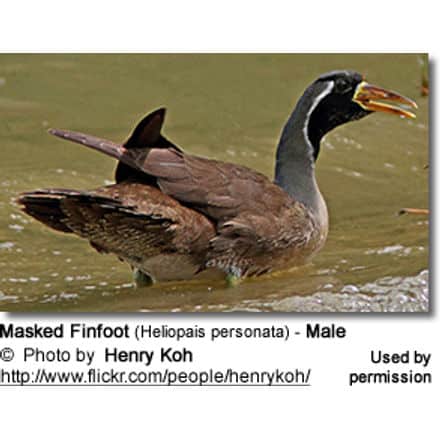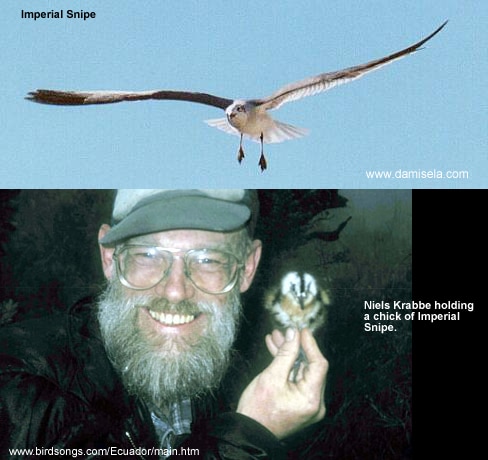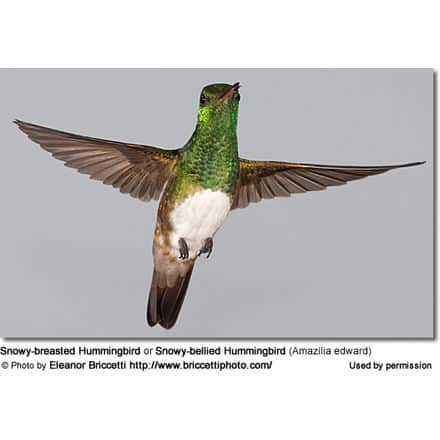Masked Finfoot
The Masked Finfoots (Heliopais personata) – also known as Asian Finfoot – is an aquatic bird with a scattered distribution from Eastern India down through Southeast Asia, where it is usually found near rivers and lakes.
Alternate (Global) Names
Chinese: ????? … Czech: Chrástalec indický, ch?ástalec maskový … Danish: Asiatisk Svømmerikse … Dutch: Maskerfuutkoet … Estonian: aasia redulind … Finnish: Aasianuikkukana … French: Grébifoulque asiatique, Grébifoulque d’Asie, Héliornis asiatique … German: IndischeBinsenralle, Maskenbinsenralle, Maskenralle … Indonesian: Pedendang Topeng … Italian: Rallo tuffatore asiatico, Svasso folaga asiatico … Japanese: ajiahireashi … Malay: Pedendang … Norwegian: Gulnebbsvømmerikse … Polish: perkolyska indyjska, perko?yska indyjska … Russian: ????????? ??????????, ????????? ???????? ?????????? … Slovak: chriaštelovec žltozobý … Spanish: Ave de Sol Asiática, Ave del sol asiática, Avesol Asiático … Swedish: Asiatisk simrall … Thai: ????????, ???????? … Vietnamese: Chn b?i
Distribution:
Masked Finfoots have a patchy distribution from north-east India (Assam) and Bangladesh, through Myanmar, Thailand, Cambodia, Laos, and Vietnam to Peninsular Malaysia, northwestern Sumatra, and Java (one record), in Indonesia.
They require large bodies of water containing vegetation; these provide protective covering on their banks. Their range includes forest, wooded savannah, flooded forest, reed beds, and mangrove swamps.
Finfoots are highly secretive and territorial most of the time and definitely during breeding season. Although they do not migrate, they do disperse in order to form new colonies in preferred habitats. Since they do not fly well, they stay near shady, calm waterways.
The Finfoot is generally viewed alone or in pairs. So secretive are they that even experienced ornithologists have difficulty locating them. This makes them a prized sighting for birders and twitchers, who will go to extreme lengths to spot these rare birds.

Status
The Masked Finfoot is classified as Endangered as it is considered to be facing a very high risk of extinction in the wild as its population suffered a steep decline throughout its range.
It is now believed that they now number in the low thousands, and possibly even fewer than 1,000.
Description
Masked Finfoots measure about 22 inches or 56 cm in length (including the tail). They have long necks, small heads, slender bodies, broad tails, and long, tapered, sharp, pointed bills.
The Masked Finfoot’s legs and feet are pale green, unlike grebes, they are capable of walking well and even moving quickly on land.
This species’ common name was derived from their webbed, lobed feet that allow them to be agile and graceful underwater.
The plumage is pale underneath and dark on top. The female is lighter than the male.
In observing the Masked Finfoot, you will note that the male and female both have a black mask and eyebrow that contrasts with a white eye ring and lateral stripe on the back of the neck.
The rest of the neck is grey with a pale-colored breast, and the back, wings, and tail are a rich brown.
The sexes differ in that the male’s chin is black and the female’s chin is white.
Diet / Feeding
The Finfoot feeds on underwater invertebrates, including both adult and larval mayflies, mollusks, dragonflies, crustaceans, grasshoppers, crabs, frogs, snails, spiders, shrimps, millipedes, beetles, mollusks, small fish, amphibians, and some leaves and seeds.
Finfoots are thought to be highly opportunistic; rather than diving for their food, they will forage on the water’s surface near the shore for their prey.
Unlike the Grebes, they do very well on land, feeding from overhanging vegetation.
Breeding
Masked Finfoot typically starts breeding after the rainy season ends, between July – August. During the breeding season, the male Masked Finfoot develops a fleshy growth of knob-shaped tissue above its bill. The Finfoot is a monogamous species.
Both the male and female construct the nest, which is an untidy, circular pad of twigs and reeds; typically situated 1 – 3 m up on a horizontal branch often suspended above the water.
The average clutch consists of 5 – 6 creamy eggs. Whether both parents share the incubation of the eggs is disputed; some suggest the female incubates the eggs alone.
The male possesses a most unusual trait: he has skin pouches under his wings in which he carries the altricial chicks, featherless and helpless, from the nest after they hatch. He will grip them so tightly that he can carry them even while flying.





